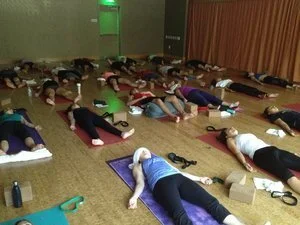Yogis! One of the things I've been talking about in class this past week comes from classical yoga and the 8 limbed practice of astanga yoga, written down by Sage Patanjali around 2000 yrs ago.
Classical yoga gives us our description and systematic approach to concentration and meditation practices, leading us into a state of samadhi, a state in which the mind is quiet. When we say we are looking to "go inward" and "quiet the mind" in yoga, we are referring to classical yoga. When the mind is quiet, the classical yogis tell us, we are able to experience the most subtle aspect of who we are, the pure consciousness part of ourselves, the part of us that is beyond the body, mind, thoughts and ego.
The classical yoga system didn't just focus on the higher, or deeper, practices of meditation, but also gave us a systematic approach to yoga, with suitable practices for a yoga practitioner at any level of practice.
A big part of the classical yoga system focused on how to prepare yourself so that you were in a more balanced state when you arrived on your mat to do your yoga practice. The classical yogis realized that the biggest distractions to going inward and quieting the mind really started with your practice off the mat.
What's going to be the biggest distraction to you off the mat?
It's probably going to be the outer world, and, especially, your interaction with other people in the outer world.
(From a karma perspective, you don't want to be distracted by the outer world and other people in the outer world but you also don't want to be a distraction to others on their journey as well.)
The classical yogis realized that conflicts with other people would be the biggest distraction to going inward, quieting the mind and finding stillness.
Ever had a fight with a loved one and then tried to get on your mat and do your practice? It's not a very successful practice, right?
The classical yogis came up with five basic restraints, that, when practiced, would help reduce conflict with others. Basically, practice these five restraints, off your mat, when interacting with other people, and you'll have more success in your practice, on your mat, and be able to find more peace of mind.
The first restraint suggested by the classical yogis was to literally reduce your conflict with others off the mat. They called this "practicing non-violence". This was on a gross physical level, but also more subtly as well. You may not be out picking 'fist fights' with everyone you meet, but what about creating an unnecessary argument? Or being disrespectful to someone? At the most subtle level, practicing non-violence is really practicing being respectful and cultivating compassion, kindness and love.
The next restraint was don't lie and "tell the truth" in your interactions with others. The mind immediately creates all kinds of conflict when you tell a lie, afraid of being found out. If you are found out in your lie, this will also lead immediately to conflict.
The next restraint was "don't steal" from other people. This one seems pretty obvious. If you take something that doesn't belong to you, this is going to lead to conflict.
The next restraint was to "be mindful of your sexual energy" when you are dealing with others. If you are being overly sexual with someone, who is not receptive to you, your behavior leads to conflict.
The last one was "don't hoard things". If you take too much of something, there's not enough to go around for everyone. This leads to conflict. We are experiencing a lot of this on a macro-cosmic level in our world right now. A few people have way too much and a lot of people don't have enough. This is part of the reason there is so much conflict in the world.
Each of these five major things, that the classical yogis encouraged, regarding interacting with others, off the mat, seem like common sense, but see if you can practice them more subtly, and then more subtly, and then even more subtly -- and you'll notice a difference in your practice, on your mat.
One of my teachers used to say that they can tell who is practicing these basic restraints from classical yoga, and at what level of subtlety each person's practice is at, just by watching people walk into the room to begin their practice.
If you are living in chaos you carry that with you everywhere you go.
If you are practicing regularly, for a long time, you will notice that when you check in at the beginning of class, you are more balanced than when you checked in at the beginning of class, when you first started your yoga practice. If that's not the case for you, then you need to do some work off of your mat. In the beginning, yoga is often just a coping tool, but remember, 1 hour, or 90 mins, of practice a day, will never compensate for 23 hours of living in chaos, with lots of conflict in your life. At a certain point, you realize that you have to take your practice off your mat if you want to go anywhere with your practice on your mat.
If you aren't really getting anywhere in your meditation practice, try practicing the five restraints recommended by the classical yogis; practice non-violence, tell the truth, don't steal, be mindful of your sexual energy, and don't hoard things. You'll arrive for your practice in a more balanced state, be able to go deeper inward, and experience more peace of mind.


